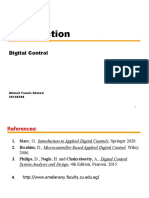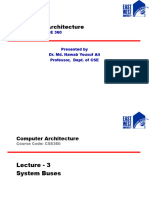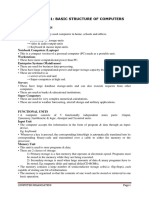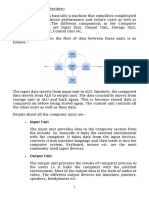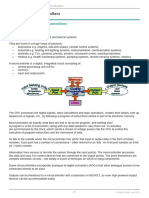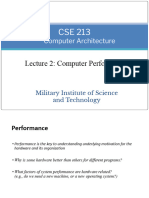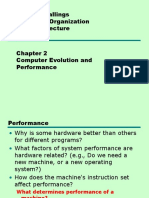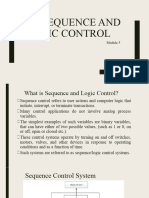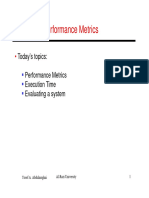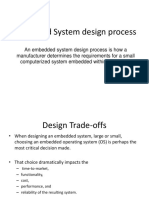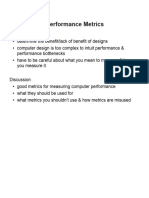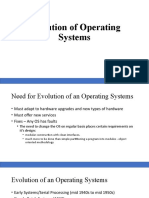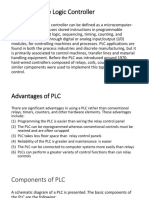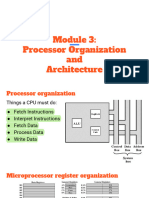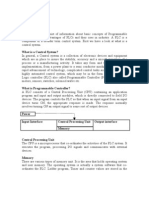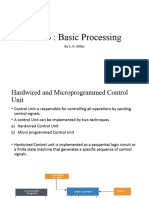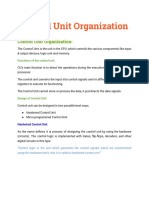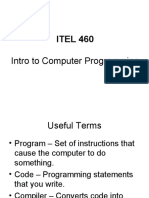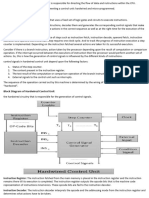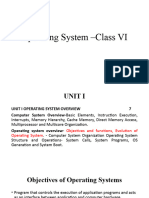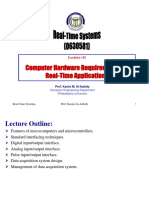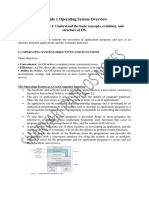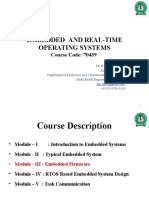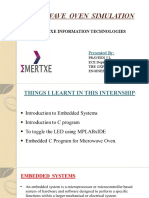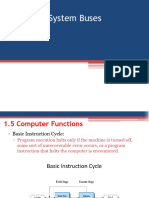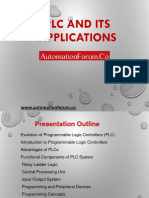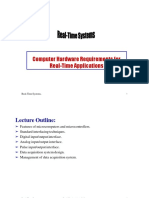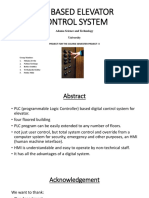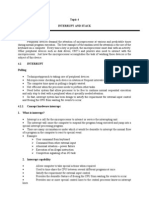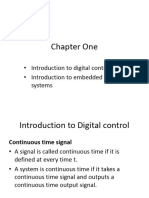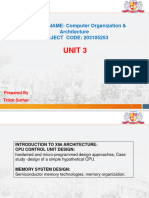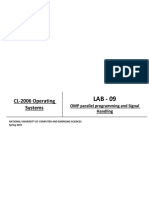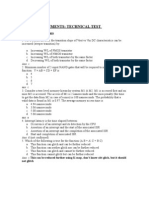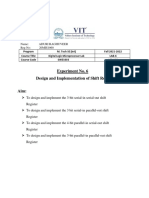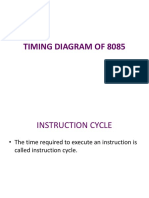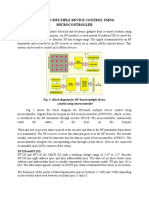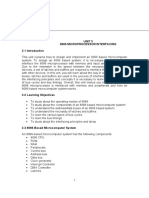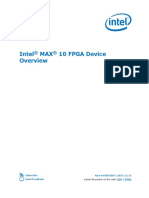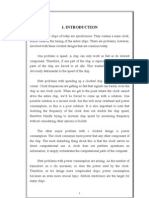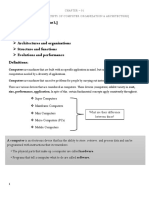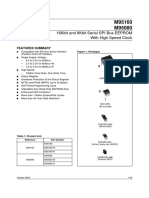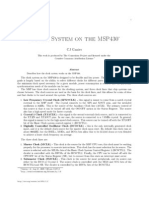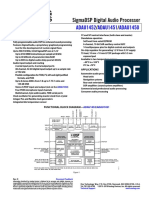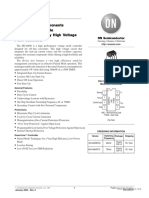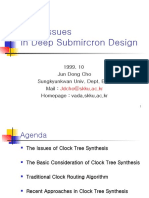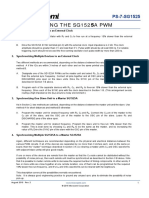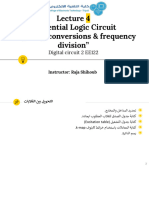0 ratings0% found this document useful (0 votes)
63 viewsRTS Lec5n
RTS Lec5n
Uploaded by
Omar Farooq MalikThis document summarizes five techniques for real-time software requirements in microcontrollers:
1. Polling continuously checks for the next sampling time and runs the control algorithm only at those times.
2. External interrupts use an external clock to trigger the control algorithm interrupt service routine at each sampling period.
3. Timer interrupts rely on the microcontroller's internal timer to trigger the control algorithm at regular sampling intervals.
4. Ballast coding independently controls loop timing by measuring instruction times and adding dummy code to achieve the sampling period.
5. An external real-time clock continuously checks the current time against the next sampling time to trigger the control algorithm.
Copyright:
© All Rights Reserved
Available Formats
Download as PDF, TXT or read online from Scribd
RTS Lec5n
RTS Lec5n
Uploaded by
Omar Farooq Malik0 ratings0% found this document useful (0 votes)
63 views17 pagesThis document summarizes five techniques for real-time software requirements in microcontrollers:
1. Polling continuously checks for the next sampling time and runs the control algorithm only at those times.
2. External interrupts use an external clock to trigger the control algorithm interrupt service routine at each sampling period.
3. Timer interrupts rely on the microcontroller's internal timer to trigger the control algorithm at regular sampling intervals.
4. Ballast coding independently controls loop timing by measuring instruction times and adding dummy code to achieve the sampling period.
5. An external real-time clock continuously checks the current time against the next sampling time to trigger the control algorithm.
Original Description:
Assembly
Original Title
RTS-lec5n
Copyright
© © All Rights Reserved
Available Formats
PDF, TXT or read online from Scribd
Share this document
Did you find this document useful?
Is this content inappropriate?
This document summarizes five techniques for real-time software requirements in microcontrollers:
1. Polling continuously checks for the next sampling time and runs the control algorithm only at those times.
2. External interrupts use an external clock to trigger the control algorithm interrupt service routine at each sampling period.
3. Timer interrupts rely on the microcontroller's internal timer to trigger the control algorithm at regular sampling intervals.
4. Ballast coding independently controls loop timing by measuring instruction times and adding dummy code to achieve the sampling period.
5. An external real-time clock continuously checks the current time against the next sampling time to trigger the control algorithm.
Copyright:
© All Rights Reserved
Available Formats
Download as PDF, TXT or read online from Scribd
Download as pdf or txt
0 ratings0% found this document useful (0 votes)
63 views17 pagesRTS Lec5n
RTS Lec5n
Uploaded by
Omar Farooq MalikThis document summarizes five techniques for real-time software requirements in microcontrollers:
1. Polling continuously checks for the next sampling time and runs the control algorithm only at those times.
2. External interrupts use an external clock to trigger the control algorithm interrupt service routine at each sampling period.
3. Timer interrupts rely on the microcontroller's internal timer to trigger the control algorithm at regular sampling intervals.
4. Ballast coding independently controls loop timing by measuring instruction times and adding dummy code to achieve the sampling period.
5. An external real-time clock continuously checks the current time against the next sampling time to trigger the control algorithm.
Copyright:
© All Rights Reserved
Available Formats
Download as PDF, TXT or read online from Scribd
Download as pdf or txt
You are on page 1of 17
Lecture (5)
Computer Software Requirements for
Real-
Real-Time Applications
Prof. Kasim M. Al-Aubidy
Computer Engineering Department
Philadelphia University
Summer Semester, 2011
Real-Time Systems, Prof. Kasim Al-Aubidy
Lecture Outline:
Microcomputer programming.
Programming techniques.
Software requirements for real-time systems
Program development process.
Real-Time Systems, Prof. Kasim Al-Aubidy
Microcontroller Programming:
Real-Time Systems, Prof. Kasim Al-Aubidy $
Microcontroller Programming:
• MCs have traditionally been programmed using the assembly language of the
target device. As a result, the assembly languages of the microcontrollers
manufactured by different firms are totally different and the user has to learn a
new language before being able program a new type of device.
• MCs can be programmed using high level languages such as BASIC, and C.
HLL Advantages:
High-level languages offer several advantages compared to the assembly language:
It is easier to develop programs using a high-level language.
• Program maintenance is much easier if the program is developed using a high-
level language.
• Testing a program developed in a high-level language is much easier.
• High-level languages are more user-friendly and less prone to making errors.
• It is easier to document a program developed using a high-level language.
HLL Disadvantages:
• The length of the code in memory is usually larger when a high-level language is
used.
• The programs developed using the assembly language usually run faster than
those developed
• using a high-level language.
Real-Time Systems, Prof. Kasim Al-Aubidy %
• The controller algorithm in a computer is implemented as a program which runs
continuously in a loop which is executed at the start of every sampling time.
Inside the loop, the desired reference value is read, the actual plant output is also
read, and the difference between the desired value and the actual value is
calculated. This forms the error signal.
• The control algorithm is then implemented and the controller output for this
sampling instant is calculated.
• This output is sent to a D/A converter which generates an analog equivalent of
the desired control action. This signal is then fed to an actuator which in turn
drives the plant to the desired point.
• The operation of the controller algorithm, assuming that the reference input and
the plant output are analog signals, the operation of the controller algorithm can
be summarized as:
Repeat Forever
When it is time for next sampling instant
Read the desired value, R, from A/D converter
Read the actual plant output, Y , from the A/D converter
Calculate the error signal, E = R Y
Calculate the controller output, U
Send the controller output to D/A converter
Wait for the next sampling instant
End
Real-Time Systems, Prof. Kasim Al-Aubidy -
• One of the important features of the above algorithms is that once they have
been started they run continuously until some event occurs to stop them or until
they are stopped manually by an operator.
• It is important to make sure that the loop is run continuously and exactly at the
same times. This is called synchronization and there are several ways in which
synchronization can be achieved in practice, such as:
– using polling in the control algorithm;
– using external interrupts for timing;
– using timer interrupts;
– ballast coding in the control algorithm;
– using an external real-time clock.
• These methods are discussed briefly through lecture.
Real-Time Systems, Prof. Kasim Al-Aubidy 2
Programming Techniques:
1. Using Polling:
• Polling is the software technique where we keep waiting until a certain event
occurs, and only then perform the required actions. This way, we wait for the
next sampling time to occur and only then run the controller algorithm.
• The polling technique is used in DDC applications since the controller cannot do
any other operation during the waiting of the next sampling time.
• The polling technique is described below as a sequence of steps:
Repeat Forever
While Not sampling time
Wait
End
Read the desired value, R
Read the actual plant output, Y
Calculate the error signal, E = R 9 Y
Calculate the controller output, U
Send the controller output to D/A converter
End
Real-Time Systems, Prof. Kasim Al-Aubidy 6
2. Using External Interrupts for Timing:
• The controller synchronization task can easily be performed using an external
interrupt.
• The controller algorithm can be written as an interrupt service routine (ISR).
• The external interrupt will typically be a clock with a period equal to the required
sampling time. Thus, the computer will run the ISR at every sampling instant.
• At the end of the ISR control is returned to the main program where the program
either waits for the occurrence of the next interrupt or can perform other tasks
(e.g. displaying data on a LCD) until the next external interrupt occurs.
• The external interrupt approach provides accurate implementation of the control
algorithm as far as the sampling time is concerned.
• One drawback of this method is that an external clock is required to generate the
interrupt pulses.
• The external interrupt technique has the advantage that the controller is not
waiting and can perform other tasks in between the sampling instants.
• The external interrupt technique of synchronization is described below as a
sequence of steps:
Main program:
Wait for an external interrupt (or perform some other tasks)
End
Real-Time Systems, Prof. Kasim Al-Aubidy :
• Interrupt service routine (ISR):
Read the desired value, R
Read the actual plant output, Y
Calculate the error signal, E = R 9 Y
Calculate the controller output, U
Send the controller output to D/A converter
Return from interrupt
Real-Time Systems, Prof. Kasim Al-Aubidy >
3. Using Timer Interrupts:
• Another popular way to perform controller synchronization is to use the timer interrupt
available on most microcontrollers.
• The controller algorithm is written inside the timer ISR, and the timer is programmed to
generate interrupts at regular intervals, equal to the sampling time.
• At the end of the algorithm control returns to the main program, which either waits for the
occurrence of the next interrupt or performs other tasks (e.g. displaying data on an LCD)
until the next interrupt occurs.
• The timer interrupt approach provides accurate control of the sampling time. Another
advantage of this technique is that no external hardware is required since the interrupts are
generated by the internal timer of the microcontroller.
• The timer interrupt technique of synchronization is described as a sequence of steps:
Main program:
Wait for a timer interrupt (or perform some other tasks)
End
Interrupt service routine (ISR):
Read the desired value, R
Read the actual plant output, Y
Calculate the error signal, E = R 9 Y
Calculate the controller output, U
Send the controller output to D/A converter
Return from interrupt
Real-Time Systems, Prof. Kasim Al-Aubidy ?
4. Using Ballast Coding:
• In this technique the loop timing is made to be independent of any external or internal
timing signals. The method involves finding the execution time of each instruction inside
the loop and then adding dummy code to make the loop execution time equal to the
required sampling time.
• This method has the advantage that no external or internal hardware is required. But one
big disadvantage is that if the code inside the loop is changed, or if the CPU clock rate of
the MC is changed, then it will be necessary to readjust the execution timing of the loop.
• The ballast coding technique of synchronization is described below as a sequence of
steps. Here, it is assumed that the loop timing needs to be increased and some dummy
code is added to the end of the loop to make the loop timing equal to the sampling time:
Do Forever:
Read the desired value, R
Read the actual plant output, Y
Calculate the error signal, E = R 9 Y
Calculate the controller output,U
Send the controller output to D/A converter
Add dummy code
...
...
Add dummy code
End
Real-Time Systems, Prof. Kasim Al-Aubidy
5. Using an External Real-Time Clock:
• This technique is similar to using an external interrupt to synchronize the control
algorithm. Here, some RT clock hardware is attached to the microcontroller where
the clock is updated at every tick; for example, depending on the clock used, 50 ticks
will be equal to 1 s if the tick rate is 20 ms. The RT clock is then read continuously
and checked against the time for the next sample. Immediately on exiting from the
wait loop the current value of the time is stored and then the time for the next
sample is updated by adding the stored time to the sampling interval. Thus, the
interval between the successive runs of the loop is independent of the execution time
of the loop. Although the external clock technique gives accurate timing, it has the
disadvantage that RT clock hardware is needed.
• The external RT clock technique of synchronization is described below as a
sequence of steps. T is the required sampling time in ticks, which is set to n at the
beginning of the algorithm. For example, if the clock rate is 50 Ticks per second,
then a Tick is equivalent to 20 ms, and if the required sampling time is 100 ms, we
should set T = 5:
Real-Time Systems, Prof. Kasim Al-Aubidy
T=n
Next Sample Time = Ticks + T
Do Forever:
While Ticks < Next Sample Time
Wait
End
Current Time = Ticks
Read the desired value, R
Read the actual plant output, Y
Calculate the error signal, E = R 9 Y
Calculate the controller output, U
Send the controller output to D/A converter
Next Sample Time=Current Time + T
End
Real-Time Systems, Prof. Kasim Al-Aubidy $
Software Requirements for Real-Time Systems:
• Computer hardware is nowadays very fast, and control computers are generally
programmed using a high-level language. The use of the assembly language is
reserved for very special and time-critical applications, such as fast, real-time
device drivers.
• C is a popular language used in most computer control applications. It is a
powerful language that enables the programmer to perform low-level operations,
without the need to use the assembly language.
• The software requirements in real-time systems can be summarized as follows:
– the ability to read data from input ports;
– the ability to send data to output ports;
– internal data transfer and mathematical operations;
– timer interrupt facilities for timing the controller algorithm.
• All of these requirements can be met by most digital computers, and, as a result,
most computers can be used as controllers in digital control systems.
Real-Time Systems, Prof. Kasim Al-Aubidy %
Program Development Process:
• The programmer writes the program, called the
source code, in Assembler language.
• This is then assembled by the Cross-Assembler
running on the host computer. The designer may
choose to test the program by simulation. This is
likely to lead to program.
• When satisfied with the program, the developer
will then download it to the program memory of
the microcontroller itself, using either a stand-
alone ‘programmer’ linked to the host computer
or a programming facility designed into the
embedded system itself.
• The designer will then test the program running
in the actual hardware. Again, this may lead to
changes being required in the source code.
• To develop a simple project, a selection of
different software tools is beneficial. These are
usually bundled together into what is called an
Integrated Development Environment (IDE),
such as PROTUS and MPLAB.
Real-Time Systems, Prof. Kasim Al-Aubidy -
Example:
Software design using
flowcharts.
Real-Time Systems, Prof. Kasim Al-Aubidy 2
Example:
Software design using
State diagrams.
Real-Time Systems, Prof. Kasim Al-Aubidy 6
You might also like
- Top Level View of Computer Function and InterconnectionDocument38 pagesTop Level View of Computer Function and Interconnectionhsi3No ratings yet
- Digital Control: Ahmed Younis Ahmed 20140208Document21 pagesDigital Control: Ahmed Younis Ahmed 20140208Ahmed YounisNo ratings yet
- 03 BusesDocument55 pages03 Busesparadox.aarNo ratings yet
- Module 1Document36 pagesModule 1shruthi p rNo ratings yet
- Computer PerformanceDocument27 pagesComputer Performancehackstar742No ratings yet
- Computer Organization NotesDocument116 pagesComputer Organization NotesrajamaheshNo ratings yet
- Module 3, Notes PDFDocument17 pagesModule 3, Notes PDFShankar MNo ratings yet
- CSADocument68 pagesCSASonu LakraNo ratings yet
- Mbed Course Notes - Timers and InterruptsDocument20 pagesMbed Course Notes - Timers and InterruptszaddlerNo ratings yet
- Programmable Logic Controller (PLC) Is A Digital Computer Used For The Automation of VariousDocument23 pagesProgrammable Logic Controller (PLC) Is A Digital Computer Used For The Automation of VariousSunil ChaudhariNo ratings yet
- Gce Electronics Book Chapter 6Document24 pagesGce Electronics Book Chapter 6m.b.homsyNo ratings yet
- L-2 (Computer Performance)Document47 pagesL-2 (Computer Performance)jubairahmed1678No ratings yet
- William Stallings Computer Organization and Architecture 8 Edition Computer Evolution and PerformanceDocument28 pagesWilliam Stallings Computer Organization and Architecture 8 Edition Computer Evolution and PerformanceHaider Ali ButtNo ratings yet
- Module 5Document73 pagesModule 5Achsah K VijuNo ratings yet
- 2 Ch1 Npsf824lec2Document19 pages2 Ch1 Npsf824lec2baraalawadi98No ratings yet
- Programmable Logic Controller: Engr - Jama Adam SalahDocument158 pagesProgrammable Logic Controller: Engr - Jama Adam Salahjustus KamenyeNo ratings yet
- More Notes On ESDocument25 pagesMore Notes On EScharles kiarieNo ratings yet
- 32 Digital ControllersDocument25 pages32 Digital ControllersKARTHIK S SNo ratings yet
- Performance MatricesDocument14 pagesPerformance Matricesakpbbk123No ratings yet
- Unit 5 ErtosDocument28 pagesUnit 5 ErtosAbhi VarmaNo ratings yet
- Fault Tolerance Techniques: Unit 3Document40 pagesFault Tolerance Techniques: Unit 3Luis AndersonNo ratings yet
- Evolution of OSDocument39 pagesEvolution of OS21PC12 - GOKUL DNo ratings yet
- Programmable Logic ControllerDocument10 pagesProgrammable Logic Controllerfarah nazNo ratings yet
- CSC 205 - 2 Instruction Processing 2023-2024Document35 pagesCSC 205 - 2 Instruction Processing 2023-2024hahnonimusNo ratings yet
- FMPM Unit 5Document41 pagesFMPM Unit 5riddheshsawntNo ratings yet
- Module 3 FinalDocument50 pagesModule 3 Finaldevpgaonkar3No ratings yet
- PLC BasicsDocument20 pagesPLC BasicsTalha_Gujjar_4662No ratings yet
- Unit 6Document31 pagesUnit 6Apurva JarwalNo ratings yet
- PLCDocument34 pagesPLCManisha Sudeep Kaintura100% (2)
- Lecture 3Document38 pagesLecture 3tarekegn utaNo ratings yet
- Control Unit OrganizationDocument5 pagesControl Unit OrganizationAniket SrivastavaNo ratings yet
- Lesson Review1 ITEL460Document42 pagesLesson Review1 ITEL460Orville BalangueNo ratings yet
- Chapter 4Document66 pagesChapter 4hb2202099No ratings yet
- PerformanceDocument35 pagesPerformanceBosong ChngNo ratings yet
- L-2 (Computer Performance)Document52 pagesL-2 (Computer Performance)Imran KhanNo ratings yet
- Hardwired Control UnitDocument2 pagesHardwired Control Unitcafeinternet2004No ratings yet
- Class 1.6Document27 pagesClass 1.6Gethzi AkilaNo ratings yet
- RTS Slids Lec4Document21 pagesRTS Slids Lec4stephen562001No ratings yet
- Module 1 Operating System OverviewDocument20 pagesModule 1 Operating System OverviewJeet NakraniNo ratings yet
- Embedded and Real-Time Operating Systems: Course Code: 70439Document21 pagesEmbedded and Real-Time Operating Systems: Course Code: 70439SrikanthNo ratings yet
- Microwave Oven 1Document20 pagesMicrowave Oven 1Praveen J LNo ratings yet
- Unit 2 - System BusesDocument28 pagesUnit 2 - System BusesS SNo ratings yet
- Intro To PLC, Its Function, and ApplicationDocument24 pagesIntro To PLC, Its Function, and ApplicationHassan M KhanNo ratings yet
- PLC Applications 1716345432Document63 pagesPLC Applications 1716345432pradeep1987coolNo ratings yet
- Share ProcesssssssDocument42 pagesShare ProcesssssssMuskan JainNo ratings yet
- RTS-unit 3Document58 pagesRTS-unit 3nawnish kumarNo ratings yet
- PLC Based Elevator Control System-1Document26 pagesPLC Based Elevator Control System-1Belete GetachewNo ratings yet
- E-Note 6169 Content Document 20240206010804PMDocument49 pagesE-Note 6169 Content Document 20240206010804PMtnimisha806No ratings yet
- Automation Project ReportDocument32 pagesAutomation Project ReportVicky Chaudhary100% (1)
- CSC159 Ch4 Interrupt - StackDocument14 pagesCSC159 Ch4 Interrupt - StackMohd FaizrulNo ratings yet
- Chapter OneDocument51 pagesChapter Oneasresahegnmeklit13No ratings yet
- Unit 3Document73 pagesUnit 3Davda NishitNo ratings yet
- Lab 12Document17 pagesLab 12Naz MemonNo ratings yet
- Assignment-2 Ami Pandat Parallel Processing: Time ComplexityDocument12 pagesAssignment-2 Ami Pandat Parallel Processing: Time ComplexityVICTBTECH SPUNo ratings yet
- PLC 2Document26 pagesPLC 2UM ZaidNo ratings yet
- Faulttolerancech5 150426005118 Conversion Gate02Document24 pagesFaulttolerancech5 150426005118 Conversion Gate02Sofiene GuedriNo ratings yet
- Explain The Parts of The NC Machine/ Explain The Block Diagram of NC Machine. (3/4 Marks)Document5 pagesExplain The Parts of The NC Machine/ Explain The Block Diagram of NC Machine. (3/4 Marks)rajeshNo ratings yet
- PLC Programming & Implementation: An Introduction to PLC Programming Methods and ApplicationsFrom EverandPLC Programming & Implementation: An Introduction to PLC Programming Methods and ApplicationsNo ratings yet
- Practical, Made Easy Guide To Building, Office And Home Automation Systems - Part OneFrom EverandPractical, Made Easy Guide To Building, Office And Home Automation Systems - Part OneNo ratings yet
- Preliminary Specifications: Programmed Data Processor Model Three (PDP-3) October, 1960From EverandPreliminary Specifications: Programmed Data Processor Model Three (PDP-3) October, 1960No ratings yet
- TIDocument73 pagesTIrAM100% (8)
- Experiment No. 6 Design and Implementation of Shift RegistersDocument17 pagesExperiment No. 6 Design and Implementation of Shift RegistersRaghuveerNo ratings yet
- What Is A Timing Diagram?: Instruction CycleDocument5 pagesWhat Is A Timing Diagram?: Instruction CycleNishal NawosahNo ratings yet
- Timing Diagram of 8085 (Cs502)Document34 pagesTiming Diagram of 8085 (Cs502)aksNo ratings yet
- RF-Based Multiple Device Control Using MicrocontrollerDocument7 pagesRF-Based Multiple Device Control Using Microcontrollermv mvNo ratings yet
- Unit 3 8086 Microprocessor InterfacingDocument29 pagesUnit 3 8086 Microprocessor InterfacingDere JesusNo ratings yet
- FPGA DS 02056 3 9 MachXO2 Family Data SheetDocument122 pagesFPGA DS 02056 3 9 MachXO2 Family Data Sheetthe hoangNo ratings yet
- Intel MAX 10 FPGA Device: Subscribe Send Feedback M10-OVERVIEW - 2017.12.15 PDF HTMLDocument14 pagesIntel MAX 10 FPGA Device: Subscribe Send Feedback M10-OVERVIEW - 2017.12.15 PDF HTMLzokandza4092No ratings yet
- A Synchronous ChipDocument22 pagesA Synchronous ChipAbhinay AgrawalNo ratings yet
- USB 2.0 Board Design and Layout Guidelines: Application ReportDocument11 pagesUSB 2.0 Board Design and Layout Guidelines: Application Reportkarim salimiNo ratings yet
- DE10-Lite User ManualDocument74 pagesDE10-Lite User ManualJoel Pérez OscáteguiNo ratings yet
- F If o Depth Calculation Made Easy 2Document8 pagesF If o Depth Calculation Made Easy 2kotra devinagaphanindraNo ratings yet
- CompArch - Chapter OneDocument9 pagesCompArch - Chapter Onegirum sisayNo ratings yet
- Creativity Lab - Ee 223 B Experiment No. 4: AIM: To Make An Automatic Visitor Counter Circuit Using CD4026 IC and LDRDocument6 pagesCreativity Lab - Ee 223 B Experiment No. 4: AIM: To Make An Automatic Visitor Counter Circuit Using CD4026 IC and LDRhloNo ratings yet
- Clock SkewDocument9 pagesClock Skewnaveenchand_a6No ratings yet
- NI Tutorial 2835 enDocument14 pagesNI Tutorial 2835 enurielNo ratings yet
- 16kbit and 8kbit Serial SPI Bus EEPROM With High Speed ClockDocument40 pages16kbit and 8kbit Serial SPI Bus EEPROM With High Speed ClockDanny EversonNo ratings yet
- Fire Fighter RobotDocument39 pagesFire Fighter RobotGautam GuptaNo ratings yet
- Clock System On The MSP430: CJ GanierDocument2 pagesClock System On The MSP430: CJ GanierTufan TufanNo ratings yet
- Automatic Room Light ControllerDocument36 pagesAutomatic Room Light Controllerlove2honney100% (1)
- Adau1452 1451 1450 PDFDocument195 pagesAdau1452 1451 1450 PDFErmenegildo De La BeppaNo ratings yet
- Electronics Projects - Volume 25 PDFDocument210 pagesElectronics Projects - Volume 25 PDFSamee Ullah100% (3)
- Mc44608 Fewexternal Components Reliable and Flexible Greenline Very High Voltage PWM ControllerDocument16 pagesMc44608 Fewexternal Components Reliable and Flexible Greenline Very High Voltage PWM ControllerShamol KormokerNo ratings yet
- Clock Issues in Deep Submircron DesignDocument50 pagesClock Issues in Deep Submircron DesignRay Hua100% (1)
- ICL7135Document16 pagesICL7135JIGNESHNo ratings yet
- Nonlinearcircuits 8bit Cipher Build & BOM Vers.1: Tayda# A-1137 511-HCF4094YM013TR Tayda# A - 1339 Tayda# A - 1345Document4 pagesNonlinearcircuits 8bit Cipher Build & BOM Vers.1: Tayda# A-1137 511-HCF4094YM013TR Tayda# A - 1339 Tayda# A - 1345informagicNo ratings yet
- Synchronizing The Sg1525A PWMDocument2 pagesSynchronizing The Sg1525A PWMSandeep SNo ratings yet
- Clock Generators For SOC Processors: Printed BookDocument1 pageClock Generators For SOC Processors: Printed BookMohammad JoharNo ratings yet
- Lecture 4Document35 pagesLecture 4barajalal01No ratings yet
- Dokumen - Tips Kas 297a Maintenance Manual 006 05512 00033Document184 pagesDokumen - Tips Kas 297a Maintenance Manual 006 05512 00033plhoughtNo ratings yet

